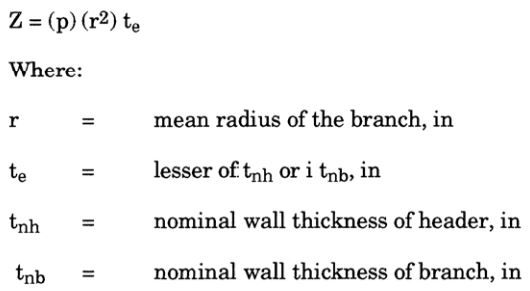1- Many of the non-power codes separate the in-plane and the out-of-plane stress intensification factors (and do not intensify torsion). For the power codes the SIF's can be computed for in-plane, out-of-plane, and torsional moments using SIF = 0.9 / h^2/3. For the petrochemical and other non-power codes:

2- The power codes do not recognize the extruded welding tee, the sweepolet, or the weldolet. The non-power codes do, and if any of these fittings are used in a power application, the engineer must consider the validity of using the stress intensification factors from the chemical codes.
3- The power codes explicitly define the equation to use for the sustained stresses. The non-power codes do not. The non-power codes do however tell the user to compute the longitudinal stresses due to sustained loads, and B31.3 Interpre-tation 4-10 issued May 8,1985 instructed the user to include the axial force term in this longitudinal stress. The power codes explicitly omit this axial force term from the definition of the sustained stress calculation.
4- Power codes do not include pressure stiffening effects on bends, while the petrochemical and related codes do.
5- Note that the power codes use the term 0.75i in the sustained stress equation, while the non-power codes historically have not. In Interpretation 1-34 issued February 23,1981 the B31.3 code permitted its users to employ the 0.75 i stress intensification term for sustained and occasional loads. (CAESAR II provides this as an option.) In Interpretation 6-03 issued December 14,1987, the B31.3 code permitted its users to ignore the stress intensification term for sustained loads. It is recommended that this latest interpretation be ignored and that i or 0.75i be used as the stress intensification factor for sustained and occasional loads.
6- Power codes provide special formulas for reduced branch connections. Nuclear and fossil codes have not come together on their interpretations as of this time, however. These rules come into effect whenever the branch diameter is less than 0.5 times the header diameter.
7- Class 1 piping rules also allow flexibility coefficients to be computed and inserted into reduced branch intersections in order to consider the flexibility of the branch relative to the header. No other piping code at this time includes this as an option.
8- B 31.3 was the first piping code to instruct the user to remove corrosion allowance from the section modulus before making sustained and occasional stress calculations. Other piping codes simply warned of the deleterious effect of corrosion when joined with cyclic loadings. Arguments are that B31.3 is instilling a false sense of security when dealing with corrosion in this manner, implying that B31.3 is leading the user to believe that he is properly considering the effects of corrosion. Other arguments state that B31.3 considers corrosion in the wrong stress calculation, and that if anything it should have been incorporated into the expansion stress calculation.
9- Some of the piping codes include longitudinal weld joint efficiency factors in their allowable stress tables. In the majority of the codes where these factors are included, the codes also instruct the user to divide the allowable stress by the joint efficiency before using the table value for flexibility calculations, thus increasing the allowable stress. Note that post-1980 B31.3 codes DO NOT include the longitudinal weld joint efficiencies in the stress tables.
10- The piping codes are unanimously silent on the point of Bourdon pressure effects. If included, the pressure will cause some distortion of the piping system. If excluded there will be no displacements due to pressure.
11- European piping codes for the most part are formulated differently than the U.S. codes. The Europeans use an effective stress calculation and compare the results directly to an allowable without emphasizing the concern for fatigue. The Swedish piping code does have a provision that allows its users to employ the ASME B31.1-1977 code providing the Swedish allowables are used.
12- Almost all piping codes allow the exact expression for pressure stress to be used in place of Pdo/4t in the sustained stress calculations. The exact pressure stress value is:

13- Most piping codes also allow the use of a increased section modulus for the stress calculations at the branch end of a reduced intersection. The reduced section modulus is calculated as:

14- Note that the B31.3 and related piping codes do not intensify the torsional stress term in the expansion or sustained stress equations, while the power codes do. This is considered an oversight on the part of the code as Markl's tests clearly indicate that the torsional moment should be intensified. This was confirmed by the research documented in WRC 330.
15- Stress indices are used in ASME Sectionlll, Class 1,2 and 3 piping codes. There are three different indices:
B - Related to gross plastic deformation (sustained stress intensification factor). C - Gives the magnitude of the primary plus secondary stress range (elastic shakedown stress intensification factor). K - When used with C, gives the magnitude of the primary plus secondary plus peak stress range (C*K is the fatigue stress intensification factor). There are three subscripts used with the stress indices: 1 - Used for pressure loadings 2 - Used for moment loadings 3 - Thermal gradient loadings As a rule of thumb, 2i = C2 * K2, where i is the stress intensification factor for the B31 codes (as discussed above).
16- In almost all cases, the cold modulus of elasticity and nominal dimensions are to be used in the flexibility analysis of piping systems. Using the cold modulus produces larger, and therefore more conservative stresses. BS 806 and ASME Class 1 codes have provisions for using material properties in the hot condition. NEMA SM23 also provides for using the hot modulus of elasticity for evaluating loads on turbine nozzles.
Read More:
To get our piping engineering services, please contact our engineering consultant department for a free quote
